Critically Evaluating Leadership for Digital Transformation
VerifiedAdded on 2022/12/30
|9
|2479
|83
Essay
AI Summary
This essay critically evaluates the ways in which leaders can manage creativity and innovation within the context of digital transformation. It begins by defining the research problem and highlighting its relevance to leadership theory and practice. The main body includes a literature review that explores various strategies for managing creativity and innovation, such as fostering collaboration, promoting communication for learning, and adopting a transformational leadership style. The essay also examines the positive and negative impacts of these strategies, emphasizing the importance of adapting to organizational culture and employee skills. A case study of Nike's digital transformation illustrates the practical application of these concepts. The conclusion summarizes the key findings and underscores the critical role of leadership in effectively managing creativity and innovation to drive successful digital transformation, ensuring organizations can adapt and thrive in the digital age.
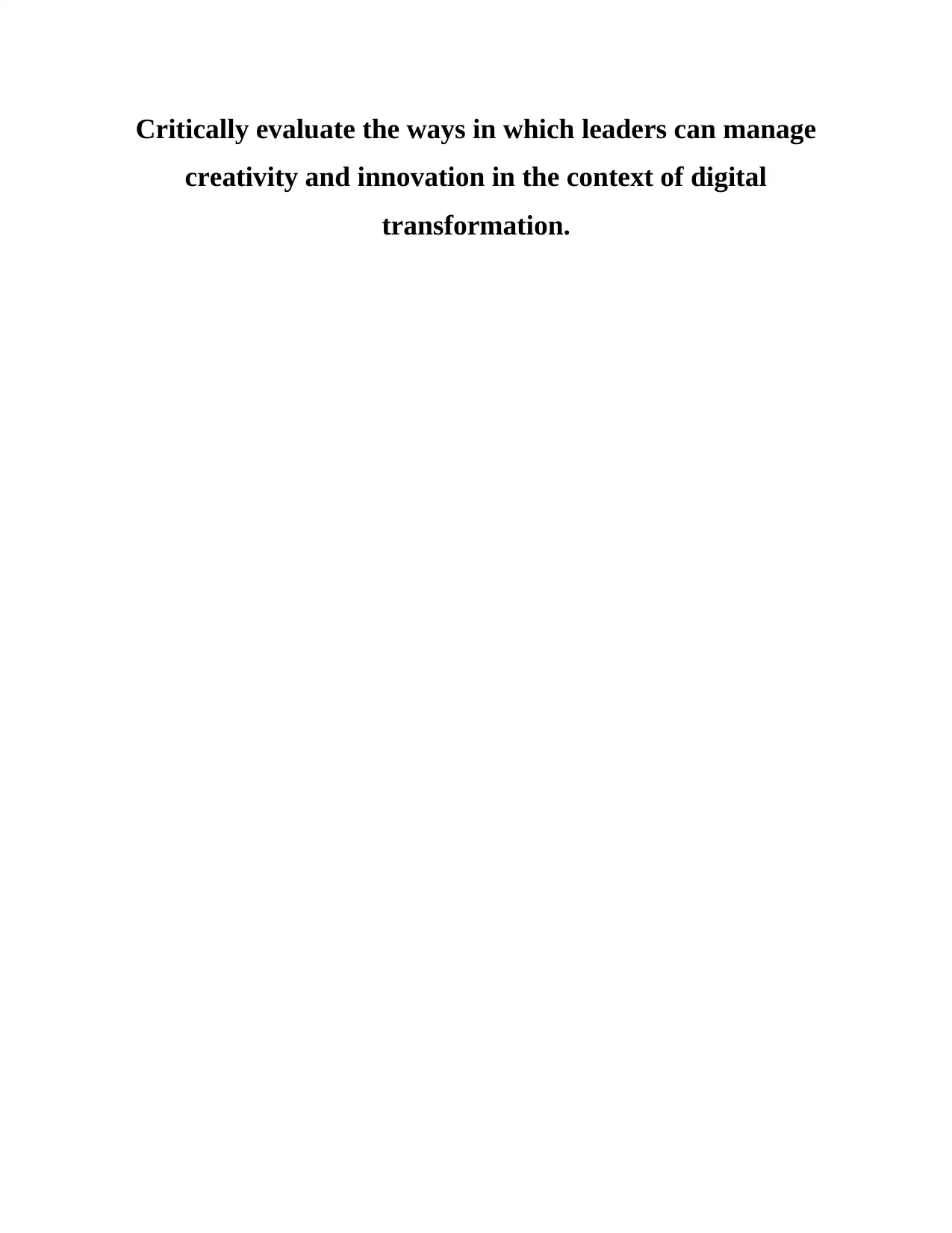
Critically evaluate the ways in which leaders can manage
creativity and innovation in the context of digital
transformation.
creativity and innovation in the context of digital
transformation.
Paraphrase This Document
Need a fresh take? Get an instant paraphrase of this document with our AI Paraphraser
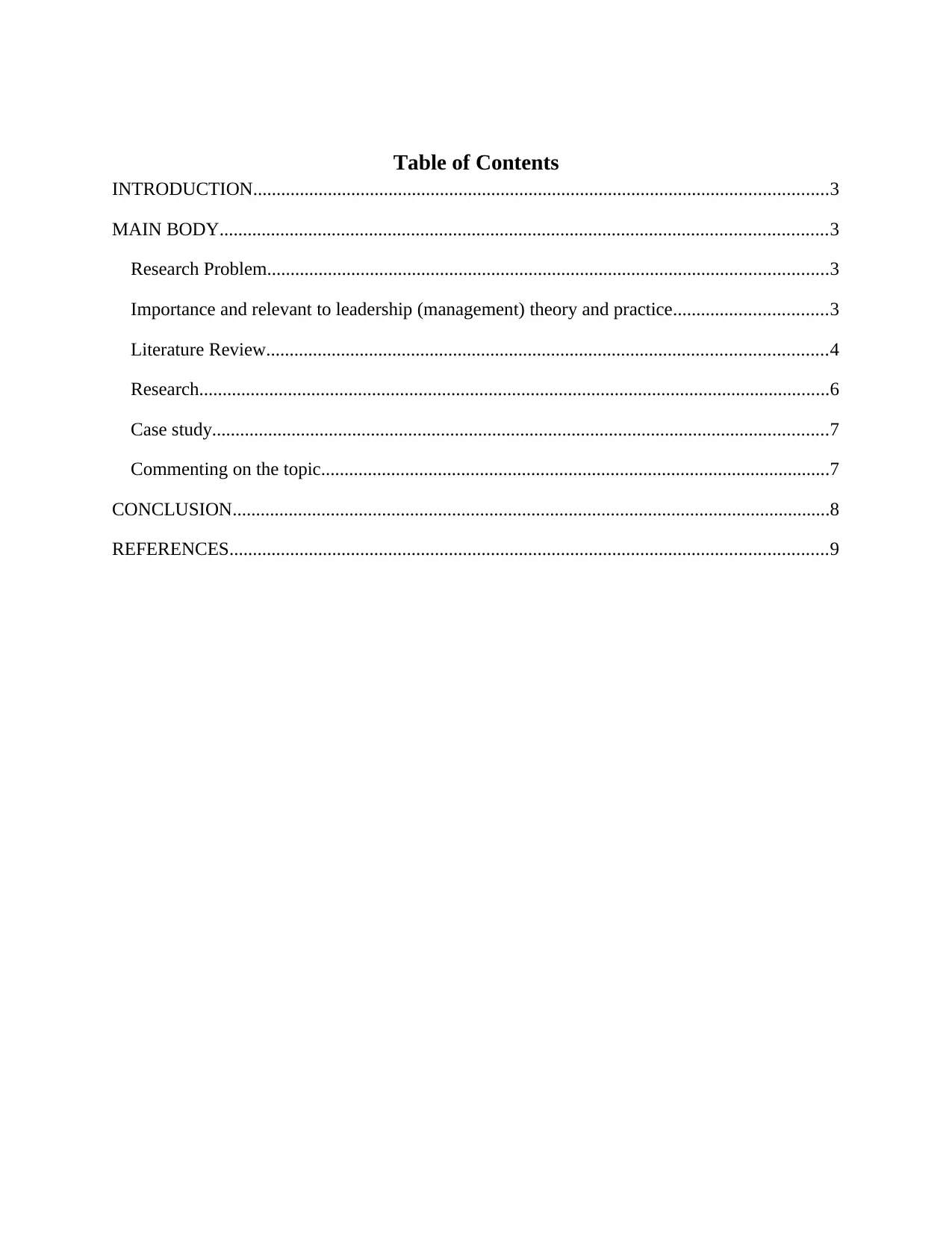
Table of Contents
INTRODUCTION...........................................................................................................................3
MAIN BODY..................................................................................................................................3
Research Problem........................................................................................................................3
Importance and relevant to leadership (management) theory and practice.................................3
Literature Review........................................................................................................................4
Research.......................................................................................................................................6
Case study....................................................................................................................................7
Commenting on the topic.............................................................................................................7
CONCLUSION................................................................................................................................8
REFERENCES................................................................................................................................9
INTRODUCTION...........................................................................................................................3
MAIN BODY..................................................................................................................................3
Research Problem........................................................................................................................3
Importance and relevant to leadership (management) theory and practice.................................3
Literature Review........................................................................................................................4
Research.......................................................................................................................................6
Case study....................................................................................................................................7
Commenting on the topic.............................................................................................................7
CONCLUSION................................................................................................................................8
REFERENCES................................................................................................................................9
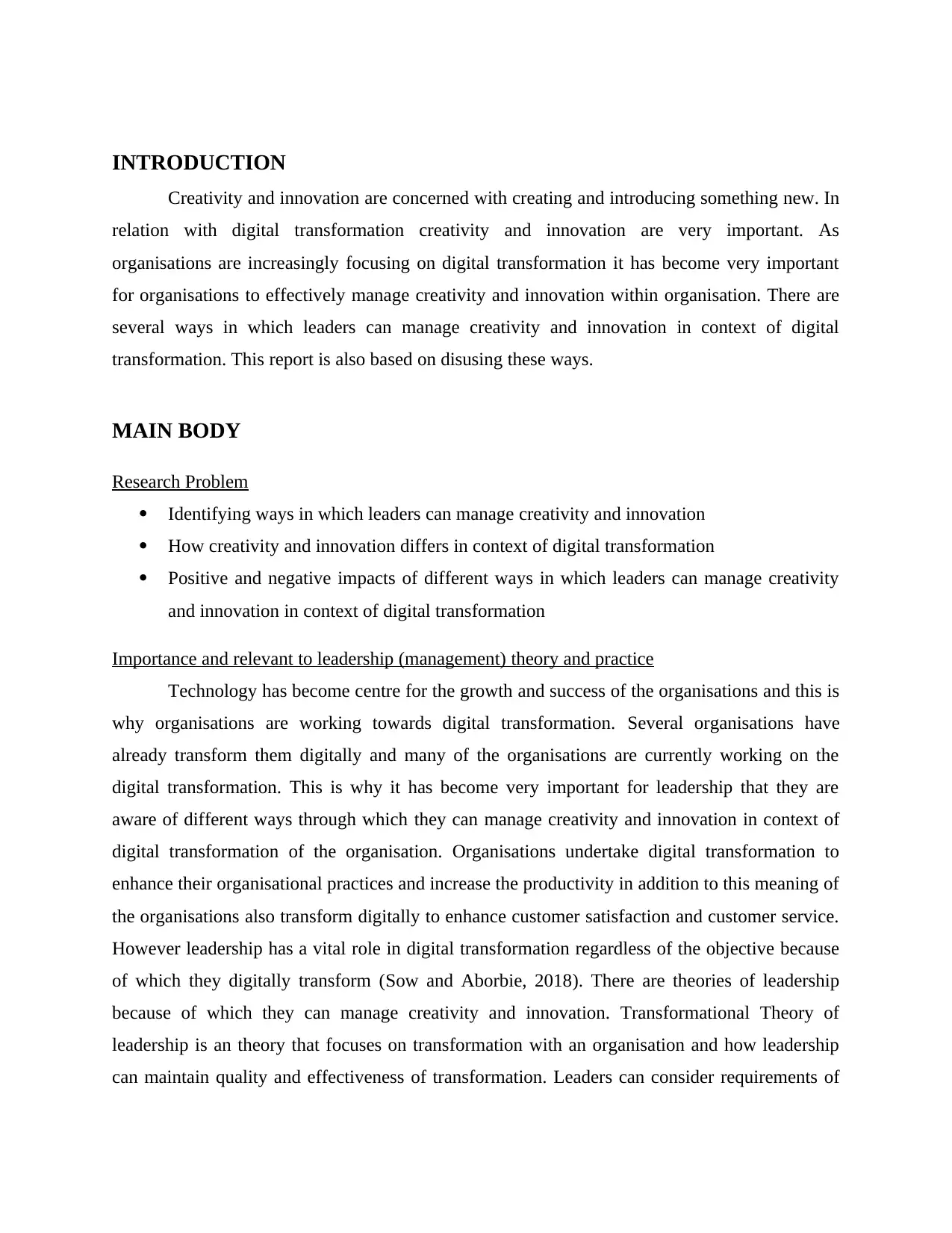
INTRODUCTION
Creativity and innovation are concerned with creating and introducing something new. In
relation with digital transformation creativity and innovation are very important. As
organisations are increasingly focusing on digital transformation it has become very important
for organisations to effectively manage creativity and innovation within organisation. There are
several ways in which leaders can manage creativity and innovation in context of digital
transformation. This report is also based on disusing these ways.
MAIN BODY
Research Problem
Identifying ways in which leaders can manage creativity and innovation
How creativity and innovation differs in context of digital transformation
Positive and negative impacts of different ways in which leaders can manage creativity
and innovation in context of digital transformation
Importance and relevant to leadership (management) theory and practice
Technology has become centre for the growth and success of the organisations and this is
why organisations are working towards digital transformation. Several organisations have
already transform them digitally and many of the organisations are currently working on the
digital transformation. This is why it has become very important for leadership that they are
aware of different ways through which they can manage creativity and innovation in context of
digital transformation of the organisation. Organisations undertake digital transformation to
enhance their organisational practices and increase the productivity in addition to this meaning of
the organisations also transform digitally to enhance customer satisfaction and customer service.
However leadership has a vital role in digital transformation regardless of the objective because
of which they digitally transform (Sow and Aborbie, 2018). There are theories of leadership
because of which they can manage creativity and innovation. Transformational Theory of
leadership is an theory that focuses on transformation with an organisation and how leadership
can maintain quality and effectiveness of transformation. Leaders can consider requirements of
Creativity and innovation are concerned with creating and introducing something new. In
relation with digital transformation creativity and innovation are very important. As
organisations are increasingly focusing on digital transformation it has become very important
for organisations to effectively manage creativity and innovation within organisation. There are
several ways in which leaders can manage creativity and innovation in context of digital
transformation. This report is also based on disusing these ways.
MAIN BODY
Research Problem
Identifying ways in which leaders can manage creativity and innovation
How creativity and innovation differs in context of digital transformation
Positive and negative impacts of different ways in which leaders can manage creativity
and innovation in context of digital transformation
Importance and relevant to leadership (management) theory and practice
Technology has become centre for the growth and success of the organisations and this is
why organisations are working towards digital transformation. Several organisations have
already transform them digitally and many of the organisations are currently working on the
digital transformation. This is why it has become very important for leadership that they are
aware of different ways through which they can manage creativity and innovation in context of
digital transformation of the organisation. Organisations undertake digital transformation to
enhance their organisational practices and increase the productivity in addition to this meaning of
the organisations also transform digitally to enhance customer satisfaction and customer service.
However leadership has a vital role in digital transformation regardless of the objective because
of which they digitally transform (Sow and Aborbie, 2018). There are theories of leadership
because of which they can manage creativity and innovation. Transformational Theory of
leadership is an theory that focuses on transformation with an organisation and how leadership
can maintain quality and effectiveness of transformation. Leaders can consider requirements of
⊘ This is a preview!⊘
Do you want full access?
Subscribe today to unlock all pages.

Trusted by 1+ million students worldwide
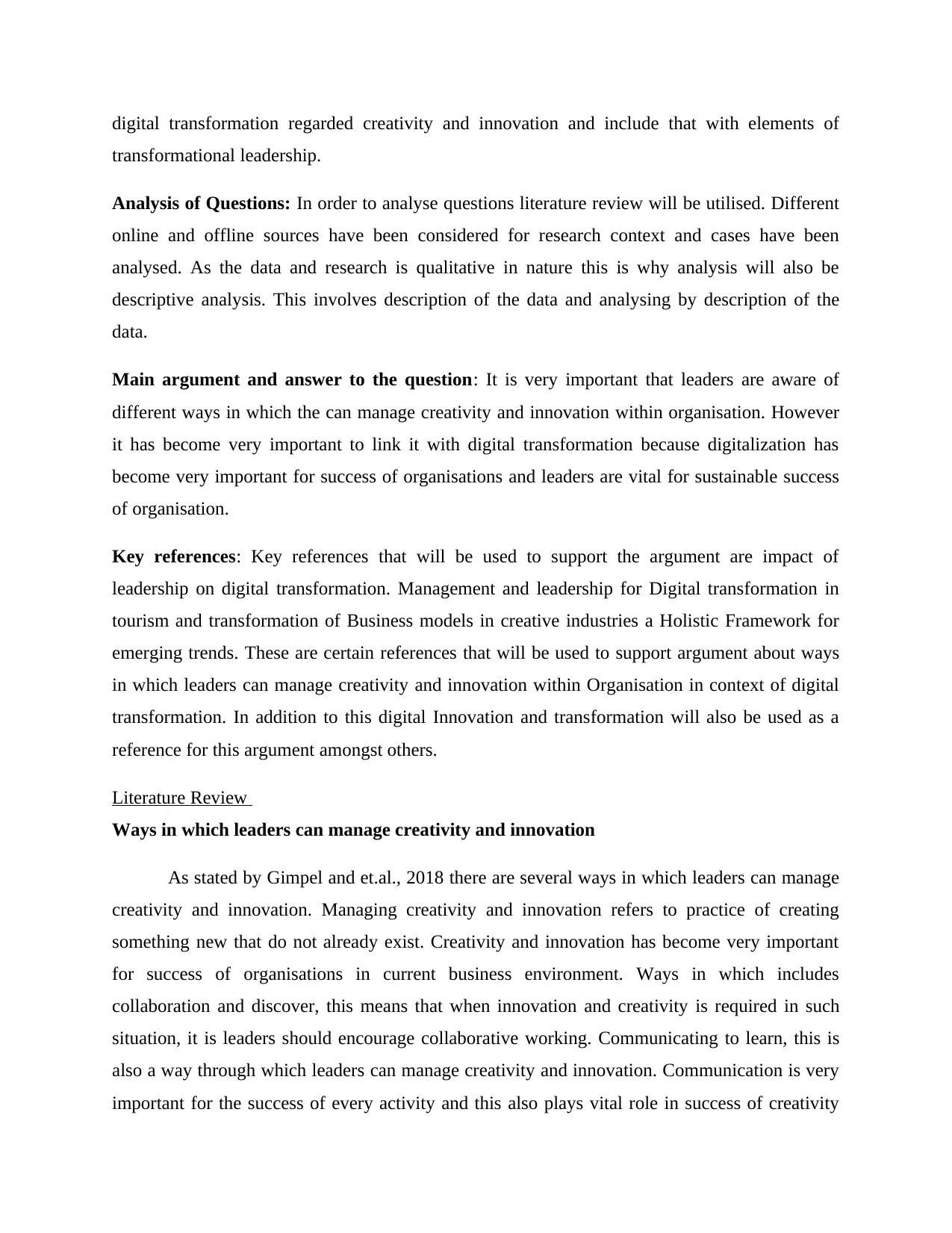
digital transformation regarded creativity and innovation and include that with elements of
transformational leadership.
Analysis of Questions: In order to analyse questions literature review will be utilised. Different
online and offline sources have been considered for research context and cases have been
analysed. As the data and research is qualitative in nature this is why analysis will also be
descriptive analysis. This involves description of the data and analysing by description of the
data.
Main argument and answer to the question: It is very important that leaders are aware of
different ways in which the can manage creativity and innovation within organisation. However
it has become very important to link it with digital transformation because digitalization has
become very important for success of organisations and leaders are vital for sustainable success
of organisation.
Key references: Key references that will be used to support the argument are impact of
leadership on digital transformation. Management and leadership for Digital transformation in
tourism and transformation of Business models in creative industries a Holistic Framework for
emerging trends. These are certain references that will be used to support argument about ways
in which leaders can manage creativity and innovation within Organisation in context of digital
transformation. In addition to this digital Innovation and transformation will also be used as a
reference for this argument amongst others.
Literature Review
Ways in which leaders can manage creativity and innovation
As stated by Gimpel and et.al., 2018 there are several ways in which leaders can manage
creativity and innovation. Managing creativity and innovation refers to practice of creating
something new that do not already exist. Creativity and innovation has become very important
for success of organisations in current business environment. Ways in which includes
collaboration and discover, this means that when innovation and creativity is required in such
situation, it is leaders should encourage collaborative working. Communicating to learn, this is
also a way through which leaders can manage creativity and innovation. Communication is very
important for the success of every activity and this also plays vital role in success of creativity
transformational leadership.
Analysis of Questions: In order to analyse questions literature review will be utilised. Different
online and offline sources have been considered for research context and cases have been
analysed. As the data and research is qualitative in nature this is why analysis will also be
descriptive analysis. This involves description of the data and analysing by description of the
data.
Main argument and answer to the question: It is very important that leaders are aware of
different ways in which the can manage creativity and innovation within organisation. However
it has become very important to link it with digital transformation because digitalization has
become very important for success of organisations and leaders are vital for sustainable success
of organisation.
Key references: Key references that will be used to support the argument are impact of
leadership on digital transformation. Management and leadership for Digital transformation in
tourism and transformation of Business models in creative industries a Holistic Framework for
emerging trends. These are certain references that will be used to support argument about ways
in which leaders can manage creativity and innovation within Organisation in context of digital
transformation. In addition to this digital Innovation and transformation will also be used as a
reference for this argument amongst others.
Literature Review
Ways in which leaders can manage creativity and innovation
As stated by Gimpel and et.al., 2018 there are several ways in which leaders can manage
creativity and innovation. Managing creativity and innovation refers to practice of creating
something new that do not already exist. Creativity and innovation has become very important
for success of organisations in current business environment. Ways in which includes
collaboration and discover, this means that when innovation and creativity is required in such
situation, it is leaders should encourage collaborative working. Communicating to learn, this is
also a way through which leaders can manage creativity and innovation. Communication is very
important for the success of every activity and this also plays vital role in success of creativity
Paraphrase This Document
Need a fresh take? Get an instant paraphrase of this document with our AI Paraphraser
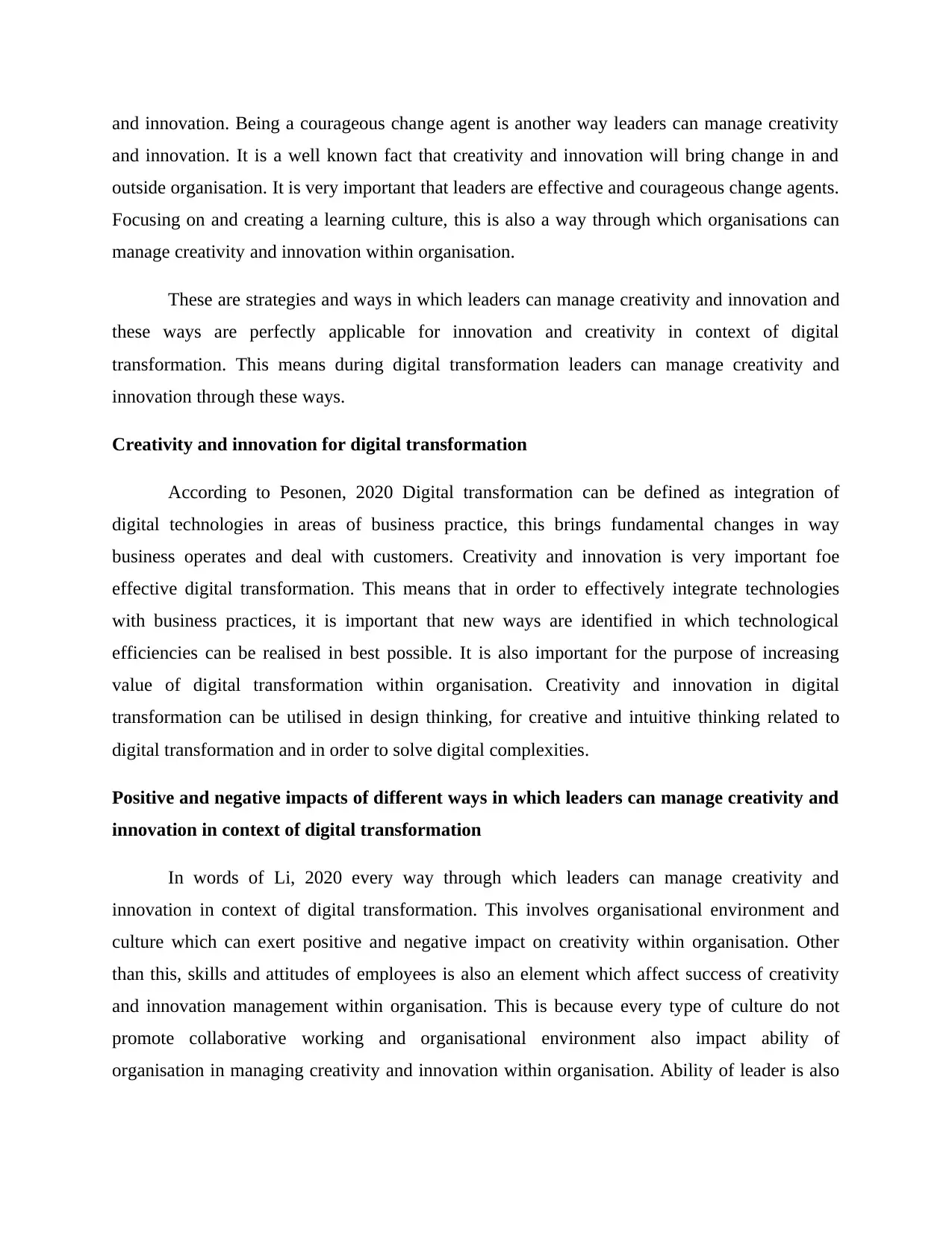
and innovation. Being a courageous change agent is another way leaders can manage creativity
and innovation. It is a well known fact that creativity and innovation will bring change in and
outside organisation. It is very important that leaders are effective and courageous change agents.
Focusing on and creating a learning culture, this is also a way through which organisations can
manage creativity and innovation within organisation.
These are strategies and ways in which leaders can manage creativity and innovation and
these ways are perfectly applicable for innovation and creativity in context of digital
transformation. This means during digital transformation leaders can manage creativity and
innovation through these ways.
Creativity and innovation for digital transformation
According to Pesonen, 2020 Digital transformation can be defined as integration of
digital technologies in areas of business practice, this brings fundamental changes in way
business operates and deal with customers. Creativity and innovation is very important foe
effective digital transformation. This means that in order to effectively integrate technologies
with business practices, it is important that new ways are identified in which technological
efficiencies can be realised in best possible. It is also important for the purpose of increasing
value of digital transformation within organisation. Creativity and innovation in digital
transformation can be utilised in design thinking, for creative and intuitive thinking related to
digital transformation and in order to solve digital complexities.
Positive and negative impacts of different ways in which leaders can manage creativity and
innovation in context of digital transformation
In words of Li, 2020 every way through which leaders can manage creativity and
innovation in context of digital transformation. This involves organisational environment and
culture which can exert positive and negative impact on creativity within organisation. Other
than this, skills and attitudes of employees is also an element which affect success of creativity
and innovation management within organisation. This is because every type of culture do not
promote collaborative working and organisational environment also impact ability of
organisation in managing creativity and innovation within organisation. Ability of leader is also
and innovation. It is a well known fact that creativity and innovation will bring change in and
outside organisation. It is very important that leaders are effective and courageous change agents.
Focusing on and creating a learning culture, this is also a way through which organisations can
manage creativity and innovation within organisation.
These are strategies and ways in which leaders can manage creativity and innovation and
these ways are perfectly applicable for innovation and creativity in context of digital
transformation. This means during digital transformation leaders can manage creativity and
innovation through these ways.
Creativity and innovation for digital transformation
According to Pesonen, 2020 Digital transformation can be defined as integration of
digital technologies in areas of business practice, this brings fundamental changes in way
business operates and deal with customers. Creativity and innovation is very important foe
effective digital transformation. This means that in order to effectively integrate technologies
with business practices, it is important that new ways are identified in which technological
efficiencies can be realised in best possible. It is also important for the purpose of increasing
value of digital transformation within organisation. Creativity and innovation in digital
transformation can be utilised in design thinking, for creative and intuitive thinking related to
digital transformation and in order to solve digital complexities.
Positive and negative impacts of different ways in which leaders can manage creativity and
innovation in context of digital transformation
In words of Li, 2020 every way through which leaders can manage creativity and
innovation in context of digital transformation. This involves organisational environment and
culture which can exert positive and negative impact on creativity within organisation. Other
than this, skills and attitudes of employees is also an element which affect success of creativity
and innovation management within organisation. This is because every type of culture do not
promote collaborative working and organisational environment also impact ability of
organisation in managing creativity and innovation within organisation. Ability of leader is also
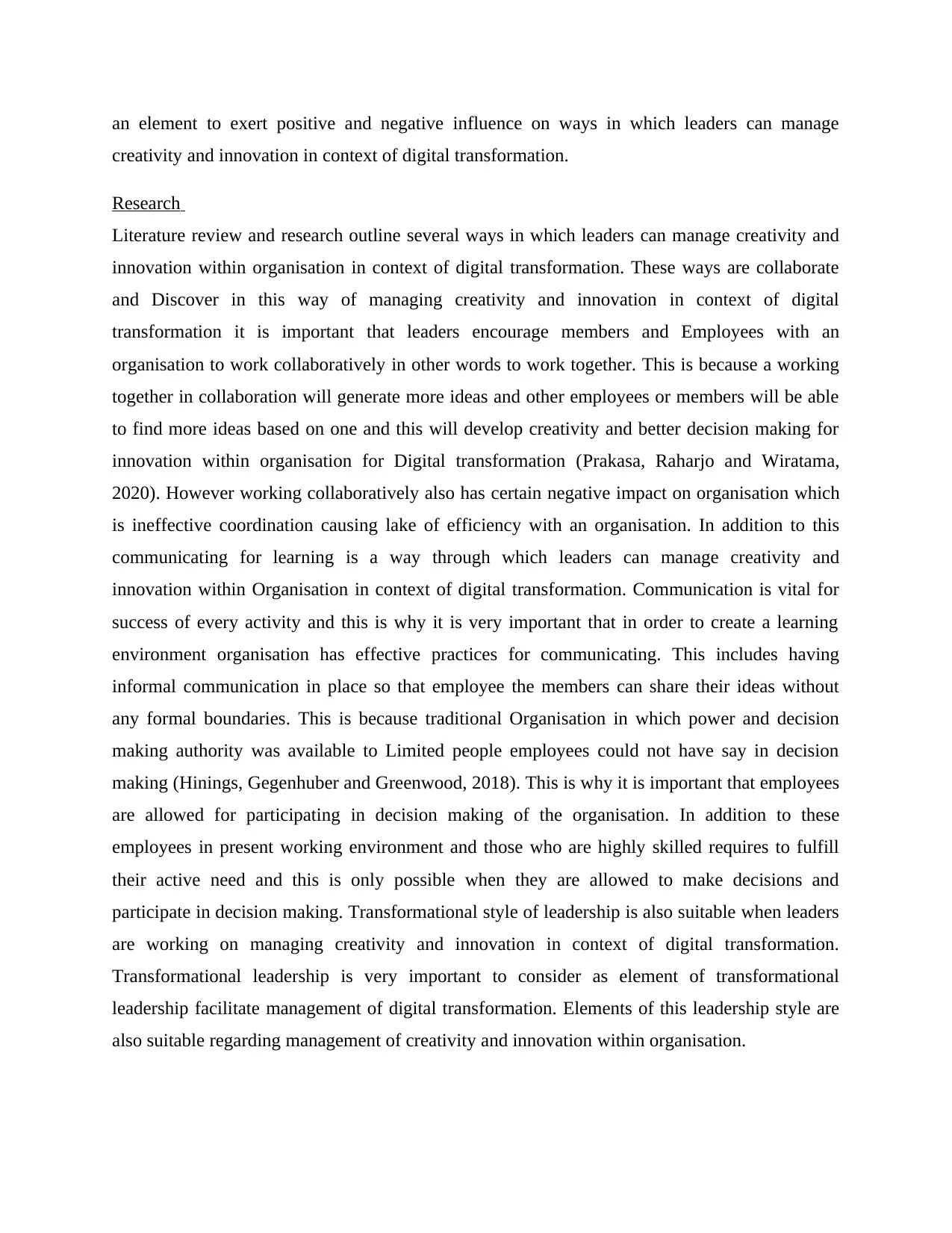
an element to exert positive and negative influence on ways in which leaders can manage
creativity and innovation in context of digital transformation.
Research
Literature review and research outline several ways in which leaders can manage creativity and
innovation within organisation in context of digital transformation. These ways are collaborate
and Discover in this way of managing creativity and innovation in context of digital
transformation it is important that leaders encourage members and Employees with an
organisation to work collaboratively in other words to work together. This is because a working
together in collaboration will generate more ideas and other employees or members will be able
to find more ideas based on one and this will develop creativity and better decision making for
innovation within organisation for Digital transformation (Prakasa, Raharjo and Wiratama,
2020). However working collaboratively also has certain negative impact on organisation which
is ineffective coordination causing lake of efficiency with an organisation. In addition to this
communicating for learning is a way through which leaders can manage creativity and
innovation within Organisation in context of digital transformation. Communication is vital for
success of every activity and this is why it is very important that in order to create a learning
environment organisation has effective practices for communicating. This includes having
informal communication in place so that employee the members can share their ideas without
any formal boundaries. This is because traditional Organisation in which power and decision
making authority was available to Limited people employees could not have say in decision
making (Hinings, Gegenhuber and Greenwood, 2018). This is why it is important that employees
are allowed for participating in decision making of the organisation. In addition to these
employees in present working environment and those who are highly skilled requires to fulfill
their active need and this is only possible when they are allowed to make decisions and
participate in decision making. Transformational style of leadership is also suitable when leaders
are working on managing creativity and innovation in context of digital transformation.
Transformational leadership is very important to consider as element of transformational
leadership facilitate management of digital transformation. Elements of this leadership style are
also suitable regarding management of creativity and innovation within organisation.
creativity and innovation in context of digital transformation.
Research
Literature review and research outline several ways in which leaders can manage creativity and
innovation within organisation in context of digital transformation. These ways are collaborate
and Discover in this way of managing creativity and innovation in context of digital
transformation it is important that leaders encourage members and Employees with an
organisation to work collaboratively in other words to work together. This is because a working
together in collaboration will generate more ideas and other employees or members will be able
to find more ideas based on one and this will develop creativity and better decision making for
innovation within organisation for Digital transformation (Prakasa, Raharjo and Wiratama,
2020). However working collaboratively also has certain negative impact on organisation which
is ineffective coordination causing lake of efficiency with an organisation. In addition to this
communicating for learning is a way through which leaders can manage creativity and
innovation within Organisation in context of digital transformation. Communication is vital for
success of every activity and this is why it is very important that in order to create a learning
environment organisation has effective practices for communicating. This includes having
informal communication in place so that employee the members can share their ideas without
any formal boundaries. This is because traditional Organisation in which power and decision
making authority was available to Limited people employees could not have say in decision
making (Hinings, Gegenhuber and Greenwood, 2018). This is why it is important that employees
are allowed for participating in decision making of the organisation. In addition to these
employees in present working environment and those who are highly skilled requires to fulfill
their active need and this is only possible when they are allowed to make decisions and
participate in decision making. Transformational style of leadership is also suitable when leaders
are working on managing creativity and innovation in context of digital transformation.
Transformational leadership is very important to consider as element of transformational
leadership facilitate management of digital transformation. Elements of this leadership style are
also suitable regarding management of creativity and innovation within organisation.
⊘ This is a preview!⊘
Do you want full access?
Subscribe today to unlock all pages.

Trusted by 1+ million students worldwide
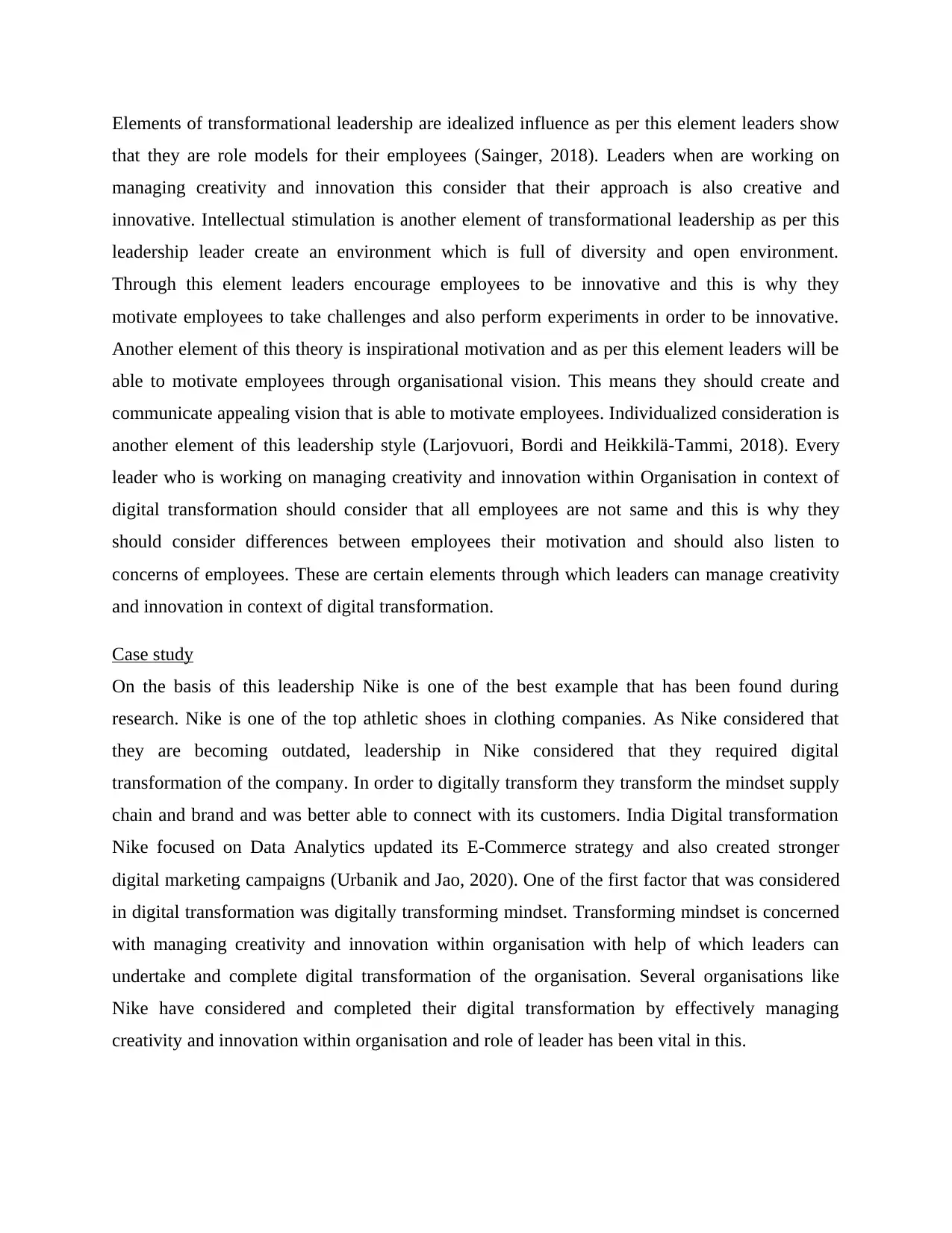
Elements of transformational leadership are idealized influence as per this element leaders show
that they are role models for their employees (Sainger, 2018). Leaders when are working on
managing creativity and innovation this consider that their approach is also creative and
innovative. Intellectual stimulation is another element of transformational leadership as per this
leadership leader create an environment which is full of diversity and open environment.
Through this element leaders encourage employees to be innovative and this is why they
motivate employees to take challenges and also perform experiments in order to be innovative.
Another element of this theory is inspirational motivation and as per this element leaders will be
able to motivate employees through organisational vision. This means they should create and
communicate appealing vision that is able to motivate employees. Individualized consideration is
another element of this leadership style (Larjovuori, Bordi and Heikkilä-Tammi, 2018). Every
leader who is working on managing creativity and innovation within Organisation in context of
digital transformation should consider that all employees are not same and this is why they
should consider differences between employees their motivation and should also listen to
concerns of employees. These are certain elements through which leaders can manage creativity
and innovation in context of digital transformation.
Case study
On the basis of this leadership Nike is one of the best example that has been found during
research. Nike is one of the top athletic shoes in clothing companies. As Nike considered that
they are becoming outdated, leadership in Nike considered that they required digital
transformation of the company. In order to digitally transform they transform the mindset supply
chain and brand and was better able to connect with its customers. India Digital transformation
Nike focused on Data Analytics updated its E-Commerce strategy and also created stronger
digital marketing campaigns (Urbanik and Jao, 2020). One of the first factor that was considered
in digital transformation was digitally transforming mindset. Transforming mindset is concerned
with managing creativity and innovation within organisation with help of which leaders can
undertake and complete digital transformation of the organisation. Several organisations like
Nike have considered and completed their digital transformation by effectively managing
creativity and innovation within organisation and role of leader has been vital in this.
that they are role models for their employees (Sainger, 2018). Leaders when are working on
managing creativity and innovation this consider that their approach is also creative and
innovative. Intellectual stimulation is another element of transformational leadership as per this
leadership leader create an environment which is full of diversity and open environment.
Through this element leaders encourage employees to be innovative and this is why they
motivate employees to take challenges and also perform experiments in order to be innovative.
Another element of this theory is inspirational motivation and as per this element leaders will be
able to motivate employees through organisational vision. This means they should create and
communicate appealing vision that is able to motivate employees. Individualized consideration is
another element of this leadership style (Larjovuori, Bordi and Heikkilä-Tammi, 2018). Every
leader who is working on managing creativity and innovation within Organisation in context of
digital transformation should consider that all employees are not same and this is why they
should consider differences between employees their motivation and should also listen to
concerns of employees. These are certain elements through which leaders can manage creativity
and innovation in context of digital transformation.
Case study
On the basis of this leadership Nike is one of the best example that has been found during
research. Nike is one of the top athletic shoes in clothing companies. As Nike considered that
they are becoming outdated, leadership in Nike considered that they required digital
transformation of the company. In order to digitally transform they transform the mindset supply
chain and brand and was better able to connect with its customers. India Digital transformation
Nike focused on Data Analytics updated its E-Commerce strategy and also created stronger
digital marketing campaigns (Urbanik and Jao, 2020). One of the first factor that was considered
in digital transformation was digitally transforming mindset. Transforming mindset is concerned
with managing creativity and innovation within organisation with help of which leaders can
undertake and complete digital transformation of the organisation. Several organisations like
Nike have considered and completed their digital transformation by effectively managing
creativity and innovation within organisation and role of leader has been vital in this.
Paraphrase This Document
Need a fresh take? Get an instant paraphrase of this document with our AI Paraphraser
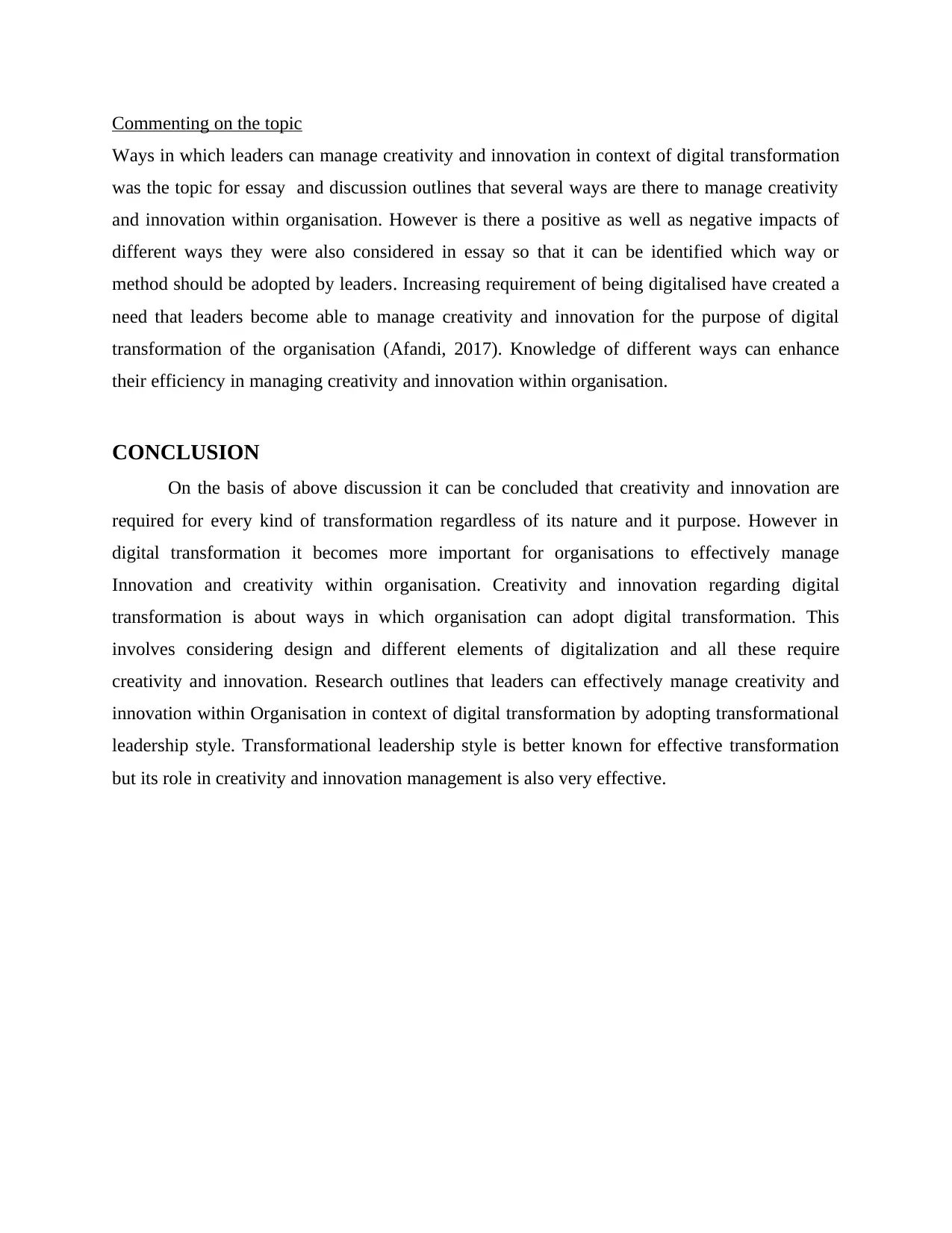
Commenting on the topic
Ways in which leaders can manage creativity and innovation in context of digital transformation
was the topic for essay and discussion outlines that several ways are there to manage creativity
and innovation within organisation. However is there a positive as well as negative impacts of
different ways they were also considered in essay so that it can be identified which way or
method should be adopted by leaders. Increasing requirement of being digitalised have created a
need that leaders become able to manage creativity and innovation for the purpose of digital
transformation of the organisation (Afandi, 2017). Knowledge of different ways can enhance
their efficiency in managing creativity and innovation within organisation.
CONCLUSION
On the basis of above discussion it can be concluded that creativity and innovation are
required for every kind of transformation regardless of its nature and it purpose. However in
digital transformation it becomes more important for organisations to effectively manage
Innovation and creativity within organisation. Creativity and innovation regarding digital
transformation is about ways in which organisation can adopt digital transformation. This
involves considering design and different elements of digitalization and all these require
creativity and innovation. Research outlines that leaders can effectively manage creativity and
innovation within Organisation in context of digital transformation by adopting transformational
leadership style. Transformational leadership style is better known for effective transformation
but its role in creativity and innovation management is also very effective.
Ways in which leaders can manage creativity and innovation in context of digital transformation
was the topic for essay and discussion outlines that several ways are there to manage creativity
and innovation within organisation. However is there a positive as well as negative impacts of
different ways they were also considered in essay so that it can be identified which way or
method should be adopted by leaders. Increasing requirement of being digitalised have created a
need that leaders become able to manage creativity and innovation for the purpose of digital
transformation of the organisation (Afandi, 2017). Knowledge of different ways can enhance
their efficiency in managing creativity and innovation within organisation.
CONCLUSION
On the basis of above discussion it can be concluded that creativity and innovation are
required for every kind of transformation regardless of its nature and it purpose. However in
digital transformation it becomes more important for organisations to effectively manage
Innovation and creativity within organisation. Creativity and innovation regarding digital
transformation is about ways in which organisation can adopt digital transformation. This
involves considering design and different elements of digitalization and all these require
creativity and innovation. Research outlines that leaders can effectively manage creativity and
innovation within Organisation in context of digital transformation by adopting transformational
leadership style. Transformational leadership style is better known for effective transformation
but its role in creativity and innovation management is also very effective.
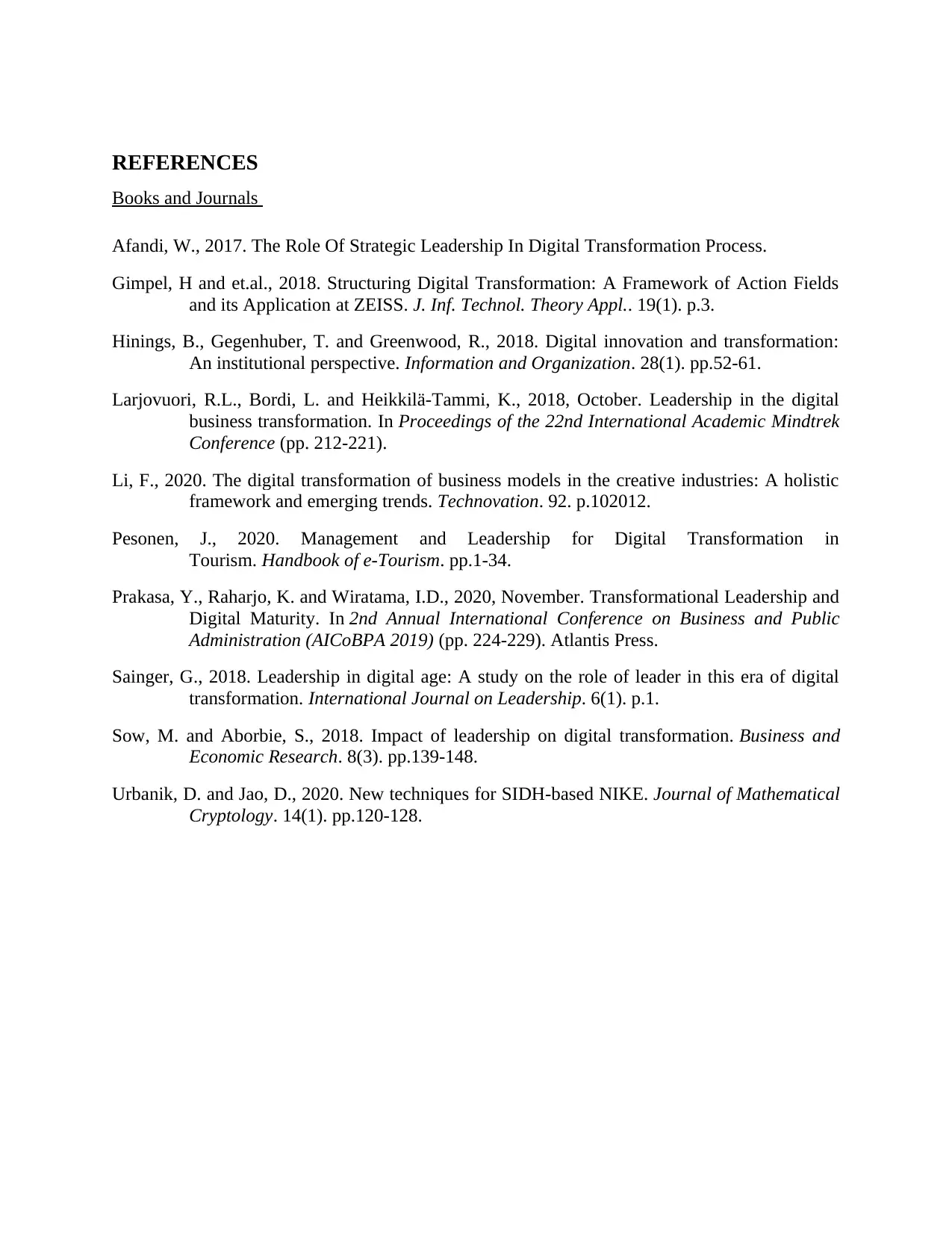
REFERENCES
Books and Journals
Afandi, W., 2017. The Role Of Strategic Leadership In Digital Transformation Process.
Gimpel, H and et.al., 2018. Structuring Digital Transformation: A Framework of Action Fields
and its Application at ZEISS. J. Inf. Technol. Theory Appl.. 19(1). p.3.
Hinings, B., Gegenhuber, T. and Greenwood, R., 2018. Digital innovation and transformation:
An institutional perspective. Information and Organization. 28(1). pp.52-61.
Larjovuori, R.L., Bordi, L. and Heikkilä-Tammi, K., 2018, October. Leadership in the digital
business transformation. In Proceedings of the 22nd International Academic Mindtrek
Conference (pp. 212-221).
Li, F., 2020. The digital transformation of business models in the creative industries: A holistic
framework and emerging trends. Technovation. 92. p.102012.
Pesonen, J., 2020. Management and Leadership for Digital Transformation in
Tourism. Handbook of e-Tourism. pp.1-34.
Prakasa, Y., Raharjo, K. and Wiratama, I.D., 2020, November. Transformational Leadership and
Digital Maturity. In 2nd Annual International Conference on Business and Public
Administration (AICoBPA 2019) (pp. 224-229). Atlantis Press.
Sainger, G., 2018. Leadership in digital age: A study on the role of leader in this era of digital
transformation. International Journal on Leadership. 6(1). p.1.
Sow, M. and Aborbie, S., 2018. Impact of leadership on digital transformation. Business and
Economic Research. 8(3). pp.139-148.
Urbanik, D. and Jao, D., 2020. New techniques for SIDH-based NIKE. Journal of Mathematical
Cryptology. 14(1). pp.120-128.
Books and Journals
Afandi, W., 2017. The Role Of Strategic Leadership In Digital Transformation Process.
Gimpel, H and et.al., 2018. Structuring Digital Transformation: A Framework of Action Fields
and its Application at ZEISS. J. Inf. Technol. Theory Appl.. 19(1). p.3.
Hinings, B., Gegenhuber, T. and Greenwood, R., 2018. Digital innovation and transformation:
An institutional perspective. Information and Organization. 28(1). pp.52-61.
Larjovuori, R.L., Bordi, L. and Heikkilä-Tammi, K., 2018, October. Leadership in the digital
business transformation. In Proceedings of the 22nd International Academic Mindtrek
Conference (pp. 212-221).
Li, F., 2020. The digital transformation of business models in the creative industries: A holistic
framework and emerging trends. Technovation. 92. p.102012.
Pesonen, J., 2020. Management and Leadership for Digital Transformation in
Tourism. Handbook of e-Tourism. pp.1-34.
Prakasa, Y., Raharjo, K. and Wiratama, I.D., 2020, November. Transformational Leadership and
Digital Maturity. In 2nd Annual International Conference on Business and Public
Administration (AICoBPA 2019) (pp. 224-229). Atlantis Press.
Sainger, G., 2018. Leadership in digital age: A study on the role of leader in this era of digital
transformation. International Journal on Leadership. 6(1). p.1.
Sow, M. and Aborbie, S., 2018. Impact of leadership on digital transformation. Business and
Economic Research. 8(3). pp.139-148.
Urbanik, D. and Jao, D., 2020. New techniques for SIDH-based NIKE. Journal of Mathematical
Cryptology. 14(1). pp.120-128.
⊘ This is a preview!⊘
Do you want full access?
Subscribe today to unlock all pages.

Trusted by 1+ million students worldwide
1 out of 9
Related Documents
Your All-in-One AI-Powered Toolkit for Academic Success.
+13062052269
info@desklib.com
Available 24*7 on WhatsApp / Email
![[object Object]](/_next/static/media/star-bottom.7253800d.svg)
Unlock your academic potential
Copyright © 2020–2025 A2Z Services. All Rights Reserved. Developed and managed by ZUCOL.




